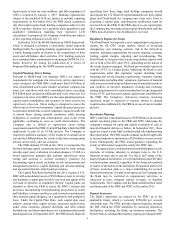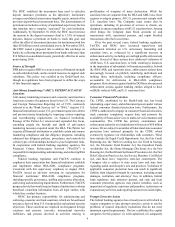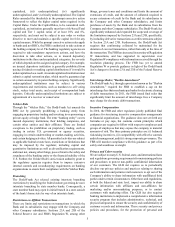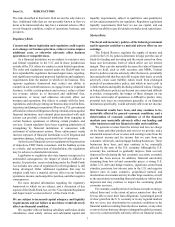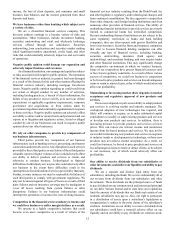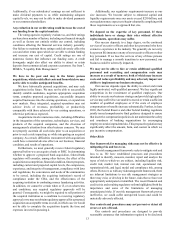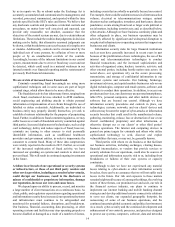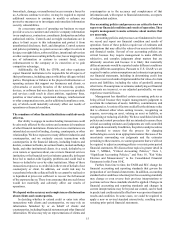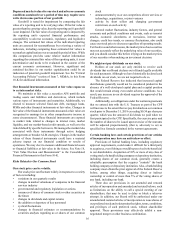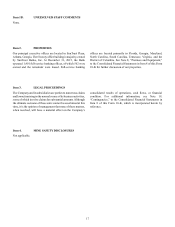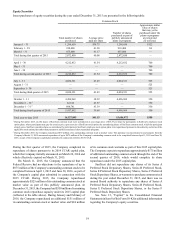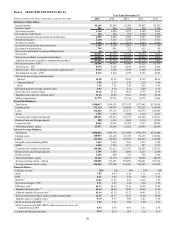SunTrust 2015 Annual Report Download - page 39
Download and view the complete annual report
Please find page 39 of the 2015 SunTrust annual report below. You can navigate through the pages in the report by either clicking on the pages listed below, or by using the keyword search tool below to find specific information within the annual report.11
on financial institutions, even where the financial institution had
already reimbursed the government or other counterparties for
actual losses.
Other Business Risk
We are subject to certain risks related to originating and
selling mortgages. We may be required to repurchase
mortgage loans or indemnify mortgage loan purchasers as a
result of breaches of representations and warranties, or
borrower fraud, and this could harm our liquidity, results of
operations, and financial condition.
We originate and often sell mortgage loans. When we sell
mortgage loans, whether as whole loans or pursuant to a
securitization, we are required to make customary
representations and warranties to the purchaser about the
mortgage loans and the manner in which they were originated.
Between 2006 and 2013, we received an elevated number of
repurchase and indemnity demands from purchasers. These
resulted in an increase in the amount of losses for repurchases.
In September 2013, we reached a settlement with Fannie Mae
and Freddie Mac to address outstanding and potential repurchase
obligations.
In addition to repurchase claims from the GSEs, we have
received indemnification claims from, and in some cases, have
been sued by, non-GSE purchasers of our loans. These claims
allege that we sold loans that failed to conform to statements
regarding the quality of the mortgage loans sold, the manner in
which the loans were originated and underwritten, and the
compliance of the loans with state and federal law. See additional
discussion in Note 19, “Contingencies,” to the Consolidated
Financial Statements and “Critical Accounting Policies” of the
MD&A in this Form 10-K.
We face certain risks as a servicer of loans.
We act as servicer and/or master servicer for mortgage loans
included in securitizations and for unsecuritized mortgage loans
owned by investors. As a servicer or master servicer for those
loans, we have certain contractual obligations to the
securitization trusts, investors or other third parties, including,
in our capacity as a servicer, foreclosing on defaulted mortgage
loans or, to the extent consistent with the applicable
securitization or other investor agreement, considering
alternatives to foreclosure such as loan modifications or short
sales and, in our capacity as a master servicer, overseeing the
servicing of mortgage loans by the servicer. Generally, our
servicing obligations are set by contract, for which we receive a
contractual fee. However, the costs to perform contracted-for
services has increased, which reduces our profitability. As a
servicer, we advance expenses on behalf of investors which we
may be unable to collect. Further, GSEs can amend their
servicing guidelines, which can increase the scope or costs of
the services we are required to perform without any
corresponding increase in our servicing fee. Further, the CFPB
has implemented national servicing standards which have
increased the scope and costs of services which we are required
to perform. In addition, there has been a significant increase in
state laws that impose additional servicing requirements that
increase the scope and cost of our servicing obligations.
If we commit a material breach of our obligations as servicer
or master servicer, we may be subject to termination if the breach
is not cured within a specified period of time following notice,
which can generally be given by the securitization trustee or a
specified percentage of security holders, causing us to lose
servicing income. In addition, we may be required to indemnify
the securitization trustee against losses from any failure by us,
as a servicer or master servicer, to perform our servicing
obligations or any act or omission on our part that involves willful
misfeasance, bad faith, or gross negligence. For certain investors
and/or certain transactions, we may be contractually obligated
to repurchase a mortgage loan or reimburse the investor for credit
losses incurred on the loan as a remedy for servicing errors with
respect to the loan. If we experience increased repurchase
obligations because of claims that we did not satisfy our
obligations as a servicer or master servicer, or increased loss
severity on such repurchases, we may have to materially increase
our repurchase reserve.
We also have received indemnification requests related to
our servicing of loans owned or insured by other parties,
primarily GSEs. Typically, such a claim seeks to impose a
compensatory fee on us for departures from GSE service levels.
In most cases, this is related to delays in the foreclosure process.
Additionally, we have received indemnification requests where
an investor or insurer has suffered a loss due to a breach of the
servicing agreement. While the number of such claims has been
small, these could increase in the future. See additional
discussion in Note 16, “Guarantees,” to the Consolidated
Financial Statements in this Form 10-K.
We are subject to risks related to delays in the foreclosure
process.
When we originate a mortgage loan, we do so with the
expectation that if the borrower defaults, our ultimate loss is
mitigated by the value of the collateral which secures the
mortgage loan. Our ability to do so depends upon our ability to
promptly foreclose upon such collateral after an appropriate cure
period. Any delay in the foreclosure process will adversely affect
us by increasing our expenses related to carrying such assets,
such as taxes, insurance, and other carrying costs, and exposes
us to losses as a result of potential additional declines in the value
of such collateral.
Clients could pursue alternatives to bank deposits, causing
us to lose a relatively inexpensive source of funding.
Checking and savings account balances and other forms of
client deposits could decrease if clients perceive alternative
investments as providing superior expected returns. When
clients move money out of bank deposits in favor of alternative
investments, we can lose a relatively inexpensive source of
funds, increasing our funding costs.
Consumers and small businesses may decide not to use banks
to complete their financial transactions, which could affect
net income.
Technology, the rise of technology-based lenders and other
changes now allow parties to complete financial transactions and
obtain certain loan products without banks. For example,
consumers and small businesses can pay bills, transfer funds and
borrow money without banks. This could result in the loss of fee




